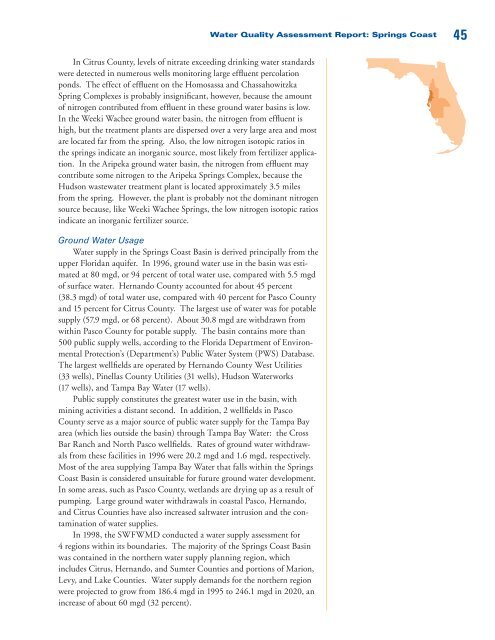Water Quality Assessment Report - Florida Department of ...
Water Quality Assessment Report - Florida Department of ...
Water Quality Assessment Report - Florida Department of ...
You also want an ePaper? Increase the reach of your titles
YUMPU automatically turns print PDFs into web optimized ePapers that Google loves.
In Citrus County, levels <strong>of</strong> nitrate exceeding drinking water standards<br />
were detected in numerous wells monitoring large effl uent percolation<br />
ponds. The effect <strong>of</strong> effl uent on the Homosassa and Chassahowitzka<br />
Spring Complexes is probably insignifi cant, however, because the amount<br />
<strong>of</strong> nitrogen contributed from effl uent in these ground water basins is low.<br />
In the Weeki Wachee ground water basin, the nitrogen from effl uent is<br />
high, but the treatment plants are dispersed over a very large area and most<br />
are located far from the spring. Also, the low nitrogen isotopic ratios in<br />
the springs indicate an inorganic source, most likely from fertilizer application.<br />
In the Aripeka ground water basin, the nitrogen from effl uent may<br />
contribute some nitrogen to the Aripeka Springs Complex, because the<br />
Hudson wastewater treatment plant is located approximately 3.5 miles<br />
from the spring. However, the plant is probably not the dominant nitrogen<br />
source because, like Weeki Wachee Springs, the low nitrogen isotopic ratios<br />
indicate an inorganic fertilizer source.<br />
Ground <strong>Water</strong> Usage<br />
<strong>Water</strong> supply in the Springs Coast Basin is derived principally from the<br />
upper <strong>Florida</strong>n aquifer. In 1996, ground water use in the basin was estimated<br />
at 80 mgd, or 94 percent <strong>of</strong> total water use, compared with 5.5 mgd<br />
<strong>of</strong> surface water. Hernando County accounted for about 45 percent<br />
(38.3 mgd) <strong>of</strong> total water use, compared with 40 percent for Pasco County<br />
and 15 percent for Citrus County. The largest use <strong>of</strong> water was for potable<br />
supply (57.9 mgd, or 68 percent). About 30.8 mgd are withdrawn from<br />
within Pasco County for potable supply. The basin contains more than<br />
500 public supply wells, according to the <strong>Florida</strong> <strong>Department</strong> <strong>of</strong> Environmental<br />
Protection’s (<strong>Department</strong>’s) Public <strong>Water</strong> System (PWS) Database.<br />
The largest wellfi elds are operated by Hernando County West Utilities<br />
(33 wells), Pinellas County Utilities (31 wells), Hudson <strong>Water</strong>works<br />
(17 wells), and Tampa Bay <strong>Water</strong> (17 wells).<br />
Public supply constitutes the greatest water use in the basin, with<br />
mining activities a distant second. In addition, 2 wellfi elds in Pasco<br />
County serve as a major source <strong>of</strong> public water supply for the Tampa Bay<br />
area (which lies outside the basin) through Tampa Bay <strong>Water</strong>: the Cross<br />
Bar Ranch and North Pasco wellfi elds. Rates <strong>of</strong> ground water withdrawals<br />
from these facilities in 1996 were 20.2 mgd and 1.6 mgd, respectively.<br />
Most <strong>of</strong> the area supplying Tampa Bay <strong>Water</strong> that falls within the Springs<br />
Coast Basin is considered unsuitable for future ground water development.<br />
In some areas, such as Pasco County, wetlands are drying up as a result <strong>of</strong><br />
pumping. Large ground water withdrawals in coastal Pasco, Hernando,<br />
and Citrus Counties have also increased saltwater intrusion and the contamination<br />
<strong>of</strong> water supplies.<br />
In 1998, the SWFWMD conducted a water supply assessment for<br />
4 regions within its boundaries. The majority <strong>of</strong> the Springs Coast Basin<br />
was contained in the northern water supply planning region, which<br />
includes Citrus, Hernando, and Sumter Counties and portions <strong>of</strong> Marion,<br />
Levy, and Lake Counties. <strong>Water</strong> supply demands for the northern region<br />
were projected to grow from 186.4 mgd in 1995 to 246.1 mgd in 2020, an<br />
increase <strong>of</strong> about 60 mgd (32 percent).<br />
<strong>Water</strong> <strong>Quality</strong> <strong>Assessment</strong> <strong>Report</strong>: Springs Coast<br />
45












